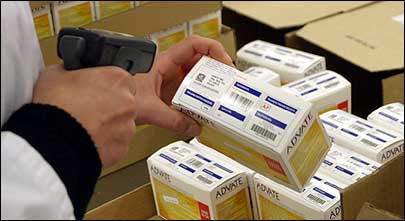Ireland’s National Center for Hereditary Coagulation Disorders (NCHCD) is testing an item-level labeling system that uses Electronic Product Codes (EPCs) to ensure that drugs for treating hemophilia can be traced and identified as they move from the manufacturer to the patient.
Located at St. James’s Hospital, in Dublin, NCHCD manages patients with inherited and acquired bleeding disorders. The trial, which began at the end of January, is the result of a two-year project to develop the system. Eventually, NCHCD hopes to try additional technologies, including RFID tags and cell phones with built-in RFID readers or bar code scanners.
NCHCD is carrying out the trial in partnership with EPC proponent and supply chain standards organization GS1 Ireland, in a project managed by the Integrated Solutions Group of Domino Printing Sciences. An EPC and the Global Trade Item Number (GTIN) are encoded in the form of 2D bar codes onto labels attached to boxes of clotting factor concentrates (CFCs), a product used to treat hemophiliacs at St James’s Hospital.
Using a networked system managed by VeriSign, EPC numbers are created and written to 2D bar code labels and applied to the boxes, cases and pallets of Advate CFCs at a manufacturing facility operated by Baxter‘s BioScience division in Belgium. The labels are then read at points throughout the supply chain.
The trial was initiated in response to the infection of hundreds of hemophiliacs with HIV and hepatitis C as a result of receiving contaminated blood products. By initially tagging Advate CFC—which is manufactured using genetically adapted cell cultures, not human blood—the hospital hopes to find a reliable way to trace human blood derivatives, which are still commonly used.
“Traditional CFC derivatives are more widely used, and we need to track both,” says Tony Walsh, European business development manager at Domino’s Integrated Solutions Group. “The trial was intended to prove the traceability concept, not show the advantages of any single product over another.” He explains that some contamination of blood products was due to mistakes such as products passing their expiration dates, not being kept at the correct temperature or being incorrectly dispensed. The key objectives of the program, therefore, are to implement real-time identification of CFCs to ensure immediate product recall, optimize stock management and reduce wastage.
Temperature sensitivity and the short shelf life of the CFC can also lead to a significant spoilage problem. “One hospital was losing £800,000 [$1,395,000] worth of CFCs each year,” he says. On an average, 40,000 vials of CFCs are administered annually to hemophiliacs in Ireland.
The new system replaces a paper-based model and provides real-time data on CFCs in the supply chain. Individual vials of Advate are packed in boxes, which are put in cardboard cases and loaded on pallets for shipping. Each box, case and pallet is fitted with a label, on which is printed a unique EPC in the form of a 2D bar code. The pallet bar codes are read as the material is loaded onto refrigerated trucks operated by logistics supplier Temperature Controlled Pharmaceuticals (TCP). The pallet and case labels are then read when stored in a warehouse in Ireland. When patients pick up their prescriptions, handheld interrogators are used to read the EPC labels to ensure the correct medication is delivered to the proper recipient.
The trial is intended to determine how the unique bar codes on each box of Advate, and the additional data captured during the supply process, will automatically validate each step of the cold chain storage and delivery process. It is also designed to help ensure that the correct dosage of Advate is prescribed to the right patient, and to update that patient’s history automatically and assist in ongoing diagnosis and future treatment.
In addition to the EPC code and GTIN number for each item, expiration dates and any other required information are also included in the 2D bar code. A group of organizations is presently studying the NCHCD project. This group includes the European Commission, the U.S. Food and Drug Administration (FDA) and the World Federation of Hemophilia.
Over the next six months, the deployment is scheduled to examine the potential of patients using mobile phones equipped with bar code scanners to read each box’s bar code during the process of self-administering the product at home. In addition, the patients will be issued wristbands or cards on which their existing unique ID numbers will be printed in the form of a 2D bar code, or encoded onto an embedded RFID tag. This will automatically update patient records at the hospital and prevent any manual errors in recording data. In a bid to further automate the identification and tracking process, Domino says it will also work to test RFID labels as a replacement for the 2D bar code labels used on the boxes, cases and pallets.




